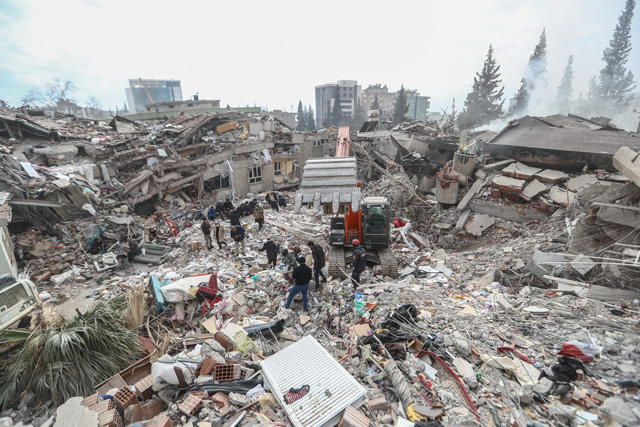25 September 2024–The five largest continental transform earthquakes since 2000 all originated on a branch of the main fault—and two researchers predict that the next great earthquake of this type will also get its start on a branch or splay fault.
Last year’s magnitude 7.8 Pazarcık earthquake in Türkiye was one of these large and damaging earthquakes, where two continental tectonic plates slide past each other horizontally. That earthquake began on a branch fault, as did the 2001 magnitude 7.8 Kokoxili earthquake in northern Tibet, the 2002 magnitude 7.9 Denali earthquake in Alaska, the 2008 magnitude 7.9 Wenchuan earthquake in China, and the 2016 magnitude 7.8 Kaikōura earthquake in New Zealand.
There are about 25,000 kilometers of continental transform faults across the globe, including some famous ones such as the U.S. San Andreas Fault, New Zealand’s Alpine Fault and Türkiye’s North Anatolia Fault. When their time comes to rupture, will they begin on a branch?
In Seismological Research Letters, Ross Stein of Temblor, Inc. and Peter Bird of the University of California, Los Angeles propose that branch faults act as “on-ramps” to generate rupture on the more mature “superhighway” continental transform faults.
At the moment, Stein and Bird’s prediction is a hypothesis that needs more testing, they acknowledge. But magnitude 7.8 or larger earthquakes take place every two to five years on average on these faults, so we shouldn’t have too long to wait to see if their prediction holds up.
“This is testable in about 10 years,” said Stein.
The findings could be useful to adapting earthquake early warning systems and might change which faults are now instrumented and monitored, he added.
The 2023 Türkiye earthquake prompted the researchers to consider the question of where and how great continental transform earthquakes originate.

“It just seemed so bizarre that a magnitude 7.8 earthquake could start on a little wannabe fault … it would be nobody’s candidate for something important,” Stein recalled. “So it raised the question: is this just a freak earthquake or is this telling us something about how earthquakes begin?”
The researchers looked back through the past 25 years of magnitude 7.8 or larger continental transform earthquakes, finding that the five largest nucleated on branch faults. They also identified a few other earthquakes of that magnitude that might have started on a branch fault—including the magnitude 7.8 earthquake that devastated San Francisco in 1906.
Branch faults were not the origin of some slightly smaller earthquakes, however, including the 1990 magnitude 7.7 Luzon earthquake in the Philippines and the 2013 magnitude 7.7 Balochistan earthquake in Pakistan, Stein and Bird concluded.
In their SRL paper, the researchers discuss why large earthquakes might not begin on the main transform fault itself, and how branch faults could initiate a rupture.
The cumulative slip along continental transform faults “smash and shear rocks within a zone about 100 meters wide around the fault,” Stein explained, forming a type of rock called cataclastite. The fractured and chewed-up rock allows rupture at very low shear stress levels, mitigating the buildup of stress that would lead to a large earthquake.
Cataclastite has a lot of pore space between rock grains that could be filled with fluids. If an earthquake were to start on an “on-ramp” branch fault, the researchers propose, the abrupt heat generated by shearing rocks could “suddenly heat up those fluids, which then expand, and it could make the fault suddenly very slippery,” transforming it into a rupture superhighway, Stein said.
“What might make these branch fault ruptures effective in triggering something huge is if they rupture at supershear velocity,” he added.
If the branch fault ruptures at supershear velocity—where the rupture itself is moving faster than the strongest seismic waves—“it could come flying into the main fault at high velocity and kick the main fault hard all at once,” Stein said.
Stein and Bird said all parts of their proposal should be tested going forward, especially since it’s unclear why branch faults might jump-start some continental transform fault earthquakes but not others.
The seismic networks that monitor faults are usually most robust along main faults “because we often think that earthquakes begin on the fault that ultimately slips,” Stein said.
But if Stein and Bird’s hypothesis is correct, “we need to take in a broader area,” he noted. “All these mangy wannabe faults that we pretty much ignore as candidates for big earthquakes actually could be very important.”
